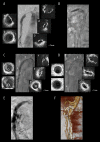Successful Endovascular Treatment of Calcified Superior Mesenteric Artery Complicated by Intramural Hematoma in Chronic Mesenteric Ischemia
- PMID: 38238995
- PMCID: PMC10806371
- DOI: 10.12659/AJCR.942641
Successful Endovascular Treatment of Calcified Superior Mesenteric Artery Complicated by Intramural Hematoma in Chronic Mesenteric Ischemia
Abstract
BACKGROUND Chronic mesenteric ischemia (CMI) is defined as ischemic symptoms caused by insufficient supply of blood to the gastrointestinal tract. Patients diagnosed with advanced symptomatic CMI should be treated subsequently, as the transition from CMI to acute mesenteric ischemia can be unpredictable. However, there is little information regarding the management of potential procedural complications during endovascular therapy (EVT) for CMI. CASE REPORT A 70-year-old man was admitted to our hospital with recurrent abdominal pain just after hemodialysis. The angiogram showed significant stenosis with heavy calcification in the proximal of the superior mesenteric artery (SMA), leading to the diagnosis of CMI. To alleviate the symptom, EVT for the stenotic lesion of the SMA was indicated. During the procedure, a cutting balloon was inflated to facilitate vessel expansion in the target lesion. As a result, intravascular ultrasound (IVUS) imaging revealed dissection into the media with extension into the medial space without reentry and demonstrated a semilunar intramural hematoma. We were able to contain the intramural hematoma by covering the whole dissection in the SMA with implantation of self-expandable stents. CONCLUSIONS This case highlights the potential of EVT for heavy calcification of the SMA complicated by dissection without reentry. Intramural hematoma was observed with IVUS examination. We were able to contain the hematoma by the implantation of self-expandable stents over the whole length of the SMA dissection under IVUS-guided EVT.
Conflict of interest statement
Figures


Similar articles
-
Recanalization of superior mesenteric artery chronic total occlusion using hybrid algorithm and dissection reentry device.Catheter Cardiovasc Interv. 2020 Jun 1;95(7):1314-1319. doi: 10.1002/ccd.28704. Epub 2020 Jan 11. Catheter Cardiovasc Interv. 2020. PMID: 31925989
-
Superior mesenteric artery stenting using embolic protection device for treatment of acute or chronic mesenteric ischemia.J Vasc Surg. 2018 Oct;68(4):1071-1078. doi: 10.1016/j.jvs.2017.12.076. Epub 2018 Apr 21. J Vasc Surg. 2018. PMID: 29685508
-
Endovascular Treatment of Chronic Mesenteric Ischemia in the Setting of Occlusive Superior Mesenteric Artery Lesions.Ann Vasc Surg. 2017 Jan;38:29-35. doi: 10.1016/j.avsg.2016.08.009. Epub 2016 Aug 28. Ann Vasc Surg. 2017. PMID: 27581131
-
Use of Shockwave Intravascular Lithotripsy in Recanalization of Calcified Visceral and Renal Arteries: A Case Report and Update of the Literature.J Endovasc Ther. 2024 Jun;31(3):485-490. doi: 10.1177/15266028221125157. Epub 2022 Sep 22. J Endovasc Ther. 2024. PMID: 36147019 Review.
-
Acute mesenteric ischemia as late complication of previous endovascular treatment in young woman. Case report and review of the literature.Ann Ital Chir. 2021 Jun 21;10:S2239253X21033119. Ann Ital Chir. 2021. PMID: 34668486 Review.
References
-
- Zeller T, Macharzina R. Management of chronic atherosclerotic mesenteric ischemia. Vasa. 2011;40:99–107. - PubMed
-
- Oderich GS, Bower TC, Sullivan TM, et al. Open versus endovascular revascularization for chronic mesenteric ischemia: Risk-stratified outcomes. J Vasc Surg. 2009;49:1472–9.e3. - PubMed
-
- Björck M, Koelemay M, Acosta S, et al. Editor’s choice – management of the diseases of mesenteric arteries and veins: Clinical practice guidelines of the European Society of Vascular Surgery (ESVS) Eur J Vasc Endovasc Surg. 2017;53:460–510. - PubMed
-
- Oderich GS, Erdoes LS, Lesar C, et al. Comparison of covered stents versus bare metal stents for treatment of chronic atherosclerotic mesenteric arterial disease. J Vasc Surg. 2013;58:1316–23. - PubMed
-
- Awouters J, Jardinet T, Hiele M, et al. Factors predicting long-term outcomes of percutaneous angioplasty and stenting of the superior mesenteric artery for chronic mesenteric ischemia. Vasa. 2021;50:431–38. - PubMed
Publication types
MeSH terms
LinkOut - more resources
Full Text Sources
Research Materials

